|
|
|
| My Favourite Planet > English > Middle East > Turkey > Pergamon > gallery 2 |
| Pergamon gallery 2 |
Pergamon art |
 |
 |
13 of 26 |
 |
 |
|
| |
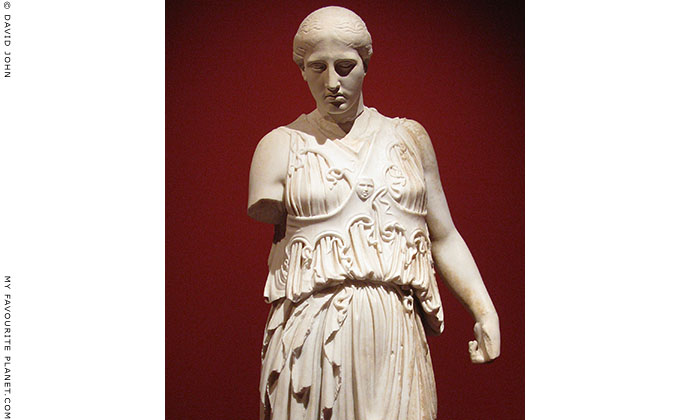
"Athena with the cross-banded aegis", from the
Sanctuary of Athena. Pergamon Museum, Berlin. |
| |
This statue of Parian marble, known as "Athena with the cross-banded aegis", is a rather masculine depiction of Athena, the patron goddess of Pergamon. The impression of masculinity in the face, body-shape and posture of the Pergamon statue is heightened in these photos by the stark top-lighting and red background used by the Pergamon Museum during its special exhibition "The return of the gods" in 2009.
It was made around 180-170 BC, during the reign of Eumenes II (ruled 197-159 BC), and is modelled on the Athena Parthenos of Pheidias, made around 450-430 BC (see next page).
The body of the statue was found during excavation in November 1880, in the ruins behind the north stoa of the Sanctuary of Athena Nikephoros (see gallery 2, pages 20-22) of the Pergamon Acropolis, without its head or lower right arm. The head, found in February 1881 further north of the find-spot of the body, was restored separately, and later added to the body in Berlin. [1]
The sculpture, now in the Pergamon Museum, Berlin, has been extensively reconstructed. The figure of Athena is 1.79 metres tall. She stands on sandals 3.3 cm high on a circular base 5 cm thick, giving the statue a total height of 1.87 metres.
When the body was first unearthed the ancient paint was still visible. Traces of colour can still be seen in the folds of the garments and on the sandals.
The aegis [2] in Greek myth refers to a goatskin prepared by the god Hephaistos which bore the head of the Gorgon Medusa. The Gorgon's head, known as the Gorgoneion, became an attribute of Athena in Greek art, and later mortal rulers, including Alexander the Great and Roman Emperor Hadrian are shown wearing this fearsome symbol on the breastplate of their armour.
The goddess wears a peplos, hanging loosely from the shoulders and breast, and overhanging a girdle of two entwined serpents which gathers the garment at the waist. (Compare the sculpting of the peplos with that of the Athena Parthenos statue on the next page.)
The aegis, worn over the peplos, comprises of two bands which cross at the back (photo, right), pass over the shoulders, cross again at the front between the breasts, where they are fastened together by the Gorgoneion, then continue under the opposite arms (detailed close-up below).
As in other statues of Athena of the Classical and Hellenistic periods, such as the "Piraeus Athena" (see photo below), the snakes which grew out of the gorgon's head have been redistributed aound the edges of the aegis. The Gorgoneion itself has here been reduced to an oval brooch; its face appears quite harmless, and only the potruding tongue reminds us of more awesome depictions of the creature.
Athena stands with her weight resting on her right leg. Her torso is arched back and turned to her right from the hips, so that her right shoulder and arm are lower and further forward of the left. Her left knee is raised and bent forward, so that she appears to be stepping foward. Her head is bent forward and to her right, but her gaze seems to be directed ahead. Her facial expression could be interpreted in several ways. At first it seems blank, but in conjunction with her aegis armour and her pose it suggests resolution and determination.
It is not certain what the figure was holding. Many statues and vase paintings show Athena carrying a shield or spear in her left hand, and in others with her right hand she is either holding or throwing a spear (as in the famous statue of Athena Promachos on the Athens Acropolis) or a small figure of Nike, the goddess of victory (in the Athena Parthenos statue, see next page). See more photos of Athena statues on Athens Acropolis gallery, page 13.
The position of the right shoulder and upper arm suggest that the rest of the arm extended forward. She would not, then, be throwing a spear or holding one at her side in the conventional way. If she held a Nike, then the arm would have been bent at the elbow, with the forearm raised, so that she could hold the victory goddess in the upturned palm of her outstretched hand, as in the Piraeus Athena (see photo below).
In this case, the pose and expression would suggest that she is stepping forward, silently and solemnly, to offer a gift: the promise of victory to the ruler and people of Pergamon by Athena Polias Nikephoros - Athena of the City, Bringer of Victory - to whom the temple on the Pergamon Acropolis was dedicated (see gallery 2, pages 20-22).
As in other masterpieces of Hellenistic Pergamese sculpture, this figure has taken the ideas of the Classical models several steps further: it is less idealized and more realistic, less static and more dynamic. The treatment of the human body, the exposed flesh and muscles as well as the draped forms, and the flowing contours and curving deep folds of the peplos create stronger rhythmic qualities. As a whole the statue is uncannily lifelike. Such works have been compared to those of the European Baroque of the 17th and 18th centuries.
This Athena is no conventional beauty (see another more feminine Athena in the photo below), but neither is she quite "the terrible warlike", "the destroyer of cities", the ferocious warrior in other depictions of her (see a statue of Athena battling the Giants in the photo below).
The face of this statue bears a close resemblance to that of the "Velletri type" Athena in the Altes Museum, Berlin (see photos below). |
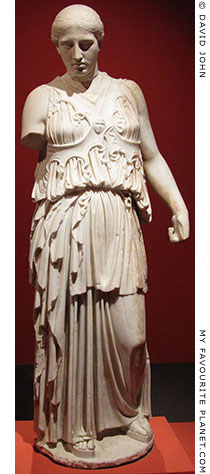
Athena statue in full length. |
| |
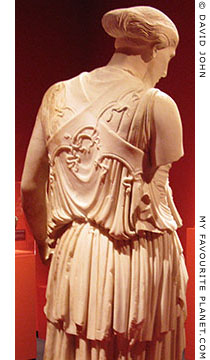
The back of the statue. |
| |
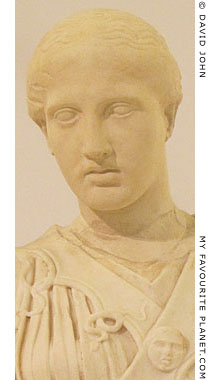
Detail of the statue, displayed
in less dramatic lighting during
the special Pergamon Museum exhibition "Pergamon. Panorama
of the Ancient Metropolis", 2012. |
| |
|
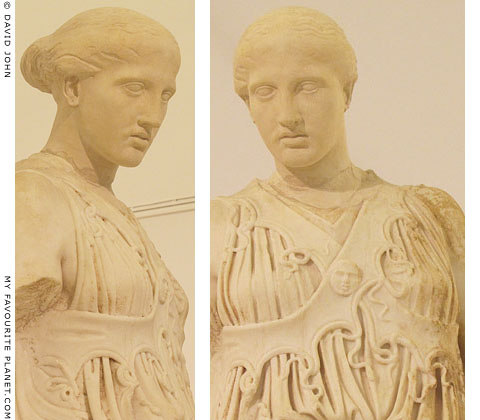
The heads of "Athena with the cross-banded aegis" and
the "Velletri type" Athena in Berlin are very similar in form:
the line of the jaw, the cheeks, the set of the eyes, the long,
straight nose (with little space between it and the top lip),
full lips, and strong, rounded chin. The eyelids of the Berlin
Velletri Athena appear larger than those of the Pergamon
sculpture. Both heads have been heavily restored. |
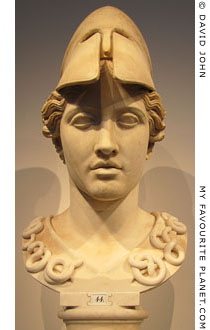
Head of Athena of the
"Velletri type", named after
a similar statue found in
Velletri, Italy, and now in
the Louvre, Paris.
Marble, Roman copy of
a Greek original, circa
390-380 BC, or perhaps
of a bronze by Kresilas,
circa 430 BC.
The bust of this restored
head is a modern addition.
Altes Museum, Berlin.
Inv. No. Sk 79. |
|
| |
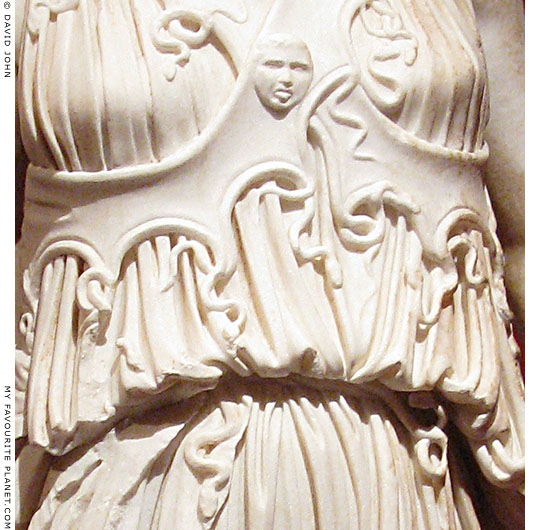
Detail of Athena's aegis and gorgon brooch, and the snake girdle of her peplos. |
|
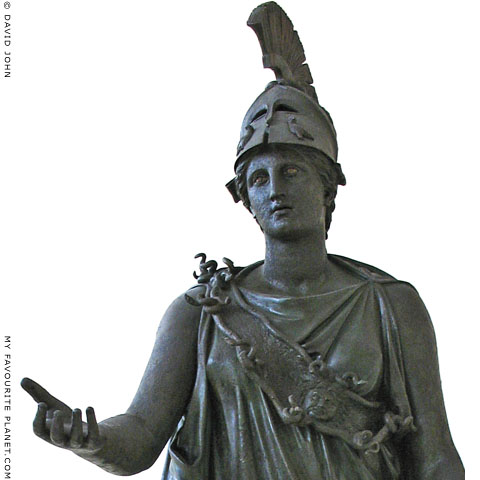
Detail of the "Piraeus Athena", a bronze statue
of Athena wearing a single banded aegis.
A much gentler image of Athena, one of whose epithets was
Glaukopi (translated as "shining-eyed", "bright-eyed" or "owl-faced").
The stone inlays of the eyes really do shine against the dark bronze.
It is thought that in her left hand she held a spear or a shield, and
in her right a statuette of Nike, an owl or a libation bowl.
The goddess wears a Doric peplos with a large overfold raised
at the back to cover her shoulders. The cheek coverings of her
Corinthian helmet are decorated with owls. Not visible in this
photo are the two flying griffins decorating the back of her helmet,
and the snake coiled around the base of the crest. Unusually, she
does not wear a girdle. The single band passing diagonally from
around her right shoulder down to below her left breast is the
aegis with a gorgoneion and snakes.
See the statue in full-length below.
It is not certain whether this statue, made circa 340-330 BC
(Hellenistic period), is an original or a classicistic work modelled
on an earlier sculpture. Some scholars have nevertheless
attributed it to either Kephisodotos or Euphranor.
Piraeus Archaeological Museum. Inv. No. 4646. |
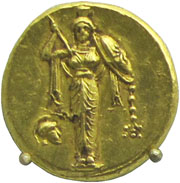
Reverse side of a gold stater, thought to have been minted in Pergamon, circa 336-320 BC, showing an Archaic cult image of Athena as Palladion, with raised spear and shield. The obverse side shows the head of Herakles. [3]
Pergamon Museum, Berlin. |
| |
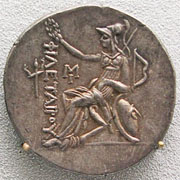
Reverse side of a Pergamese tetradrachm of Eumenes II showing Athena Nikephoros seated, with a shield at her side and holding a victory wreath over the name "Φιλέταιρου" (Philetaeros, the first Attalid ruler of Pergamon).
Circa 197-190 BC.
Pergamon Museum, Berlin.
See a similar tetradrachm
of Eumenes I on
gallery 2, page 3. |
| |
| |
Pergamon
Athena statue |
Notes, references and links |
 |
|
1. "Athena with the cross-banded aegis" in Berlin
Pergamon Museum, Berlin, Inv. No. 1111.
See: Franz Winter, Altertümer von Pergamon, Band VII, Text I: Die Skulpturen, mit Aussnahme der Altarreliefs, pages 13-25. (The antiquities of Pergamon, Volume 7, Text 1: The sculptures, with the exception of the Altar reliefs). Königliche Museen zu Berlin. Verlag von Georg Reimer, Berlin, 1908.
2. The aegis
The aegis (Greek, αἰγίς)
Excerpts from the entry on the aegis in A Dictionary of Greek and Roman Antiquities by William Smith:
"According to the mythologers, the aegis worn by Zeus was the hide of the goat Amaltheia, which had suckled him in his infancy. Hyginus relates (Poeticon astronomicon, 13) that, when he was preparing to resist the Titans, he was directed, if he wished to conquer, to wear a goat-skin with the head of the Gorgon. To this particular goatskin the term aegis was afterwards confined. Homer always represents it as part of the armour of Zeus, whom on this account he distinguishes by the epithet aegis-bearing (αἰγίοχος, aigiochos). He, however, asserts that it was borrowed on different occasions both by Apollo (Iliad, 15.229, 307-318, 360, 24.20), and by Athena (Iliad, 2.447-449, 18.204, 21.400)."
"It must also be borne in mind that the heavy shields of the ancient Greeks were in part supported by a belt or strap (τελαμών, telamon, balteus) passing over the right shoulder, and, when not elevated with the shield, descending transversely to the left hip."
"Other statues of Athena represent her in a state of repose, and with the goat-skin falling obliquely from its loose fastening over her right shoulder, so as to pass round the body under the left arm."
"In the middle of it was fixed the appalling Gorgon's head (Iliad, 5.741), and its border was surrounded with golden tassels (θύσανοι, thisanoi), each of which was worth a hecatomb [a hundred oxen] (Iliad, 2.446-449)."
William Smith, A Dictionary of Greek and Roman Antiquities.
John Murray, London, 1890. At Perseus Digital Library.
Athena puts on the aegis in Homer's Iliad:
"But Athene, daughter of Zeus that beareth the aegis, let fall upon her father's floor her soft robe, richly broidered, that herself had wrought and her hands had fashioned, and put on her the tunic of Zeus, the cloud-gatherer, and arrayed her in armour for tearful war.
About her shoulders she flung the tasselled aegis, fraught with terror, all about which Rout is set as a crown, and therein is Strife, therein Valour, and therein Onset, that maketh the blood run cold, and therein is the head of the dread monster, the Gorgon, dread and awful, a portent of Zeus that beareth the aegis.
And upon her head she set the helmet with two horns and with bosses four, wrought of gold, and fitted with the men-at-arms of an hundred cities."
A. T. Murray (translator), Homer, The Iliad, Book 5, lines 733-745. Harvard University Press, Cambridge, MA.; William Heinemann Ltd., London. 1924. At Perseus Digital Library.
Hyginus on the aegis and the Gorgoneion:
"Some have called Aex [Aix, Aιξ] the daughter of Sol [Helios], who surpassed many in beauty of body, but in contrast to this beauty, had a most horrible face. Terrified by it, the Titans begged Terra [Gaia] to hide her body, and Terra is said to have hidden her in a cave in the island of Crete.
Later she became nurse of Jove [Zeus], as we have said before. But when Jupiter [Zeus], confident in his youth, was preparing for war against the Titans, oracular reply was given to him that if he wished to win, he should carry on the war protected with the skin of a goat, aigos, and the head of the Gorgon. The Greeks call this the aegis.
When this was done, as we have shown above, Jupiter, overcoming the Titans, gained possession of the kingdom. Covering the remaining bones of the goat with a skin, he gave life to them and memorialised them, picturing them with stars. Afterwards he gave to Minerva [Athena] the aegis with which he had been protected when he won."
Hyginus, Poeticon astronomicon, 2.13, The Charioteer. At the Theoi Project.
For further information about Hyginus, see the note in Homer part 2 in the MFP People section.
The Greek Historian Herodotus of Halicarnassus (Ἡρόδοτος, circa 484 - circa 425 BC), always keen to find foreign antecedents to Greek myths and customs, believed the aegis originated in Africa:
"It would seem that the robe and aegis of the images of Athena were copied by the Greeks from the Libyan women; for except that Libyan women dress in leather, and that the tassels of their goatskin cloaks are not snakes but thongs of hide, in everything else their equipment is the same.
And in fact, the very name betrays that the attire of the statues of Pallas has come from Libya; for Libyan women wear the hairless tasselled 'aegea' over their dress, colored with madder, and the Greeks have changed the name of these aegeae into their 'aegides'.
Furthermore, in my opinion the ceremonial chant first originated in Libya: for the women of that country chant very tunefully. And it is from the Libyans that the Greeks have learned to drive four-horse chariots."
Herodotus, The Histories, Book 4, chapter 189. English translation by A. D. Godley. Harvard University Press, 1920. At Perseus Digital Library.
See also: "Alexander Aigiochos" type statues of Alexander the Great wearing the aegis and Gorgoneion. |
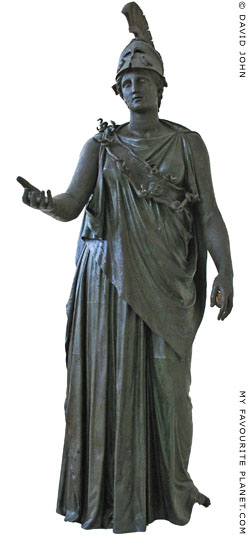
The Piraeus Athena in full length. |
| |
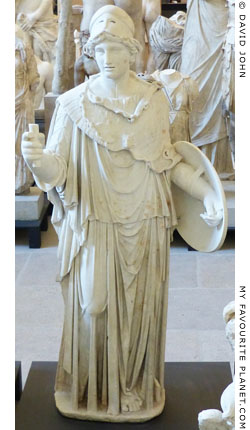
A small marble statue of Athena
wearing a Corinthian helmet,
aegis and Gorgoneion, and
carrying a reconstructed shield.
Early 2nd century AD, after a
model of the late 1st century BC.
Height 130.5 cm.
Skulpturensammlung,
Albertinum, Dresden.
Inv. No. Hm 177. |
| |
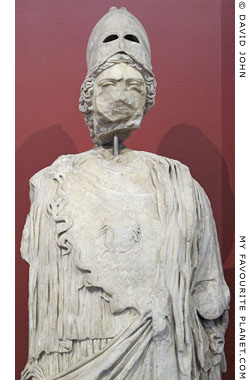
Detail of a marble statue of Athena
wearing a Corinthian helmet,
aegis and Gorgoneion.
Found in the Gymnasium, Ephesus.
Roman period. Height 184 cm,
width 55 cm, depth 33 cm.
Izmir Museum of History and Art.
Inv. No. 11. |
| |
| |
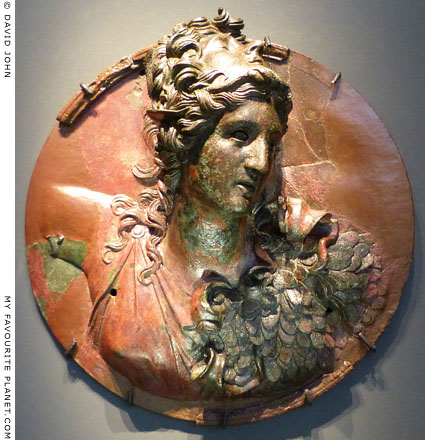
A cast bronze roundel of Athena Promachos, wearing a
sleeveless peplos, fastened at the right shoulder with
a round fibula, a helmet in the form of Medusa's head
and the aegis with a snake on the border over her left
shoulder. Her right arm is raised as if about to throw
a spear, as in statues of Athena Promachos.
A decoration from a formal chariot used for
parades, perhaps belonging to a wealthy hetairos
(royal officer) or a member of the Macedonian royal
family. Possibly from a workshop in Delos. Hellenistic,
first half of the 2nd century BC. Diameter 27 cm.
Excavated on Kyprion Agoniston Square, Thessaloniki,
during a rescue dig in a Hellenistic public building,
possibly the palace of the Macedonian kings.
Thessaloniki Archaeological Museum. Inv. No. 17540. |
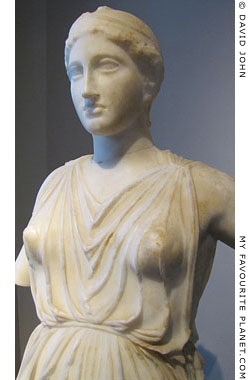
Marble statue of Athena from
Leptis Magna, Tripolitania (Lybia).
Roman, "copy of an original from
the end of the 5th century BC."
Istanbul Archaeological Museum.
Inv. No. 435 T. Cat. Mendel 532. |
|
| |
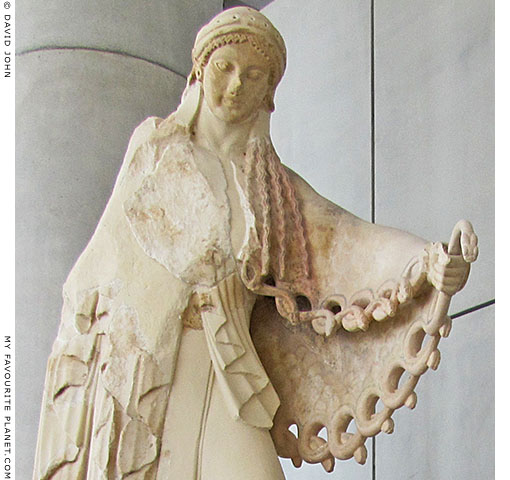
Detail of a restored Archaic statue of Athena using her
snake-fringed aegis as a weapon in a battle against the Giants.
Believed to be from the east pediment of the Old Temple
of Athena Polias on the Athens Acropolis. Circa 525 BC.
Acropolis Museum, Athens. Inv. No. Acr. 631.
|
| The pedimental sculptures depicted the Gigantomachy, the battle between the Olympian gods and the Giants or Titans. Here Athena, striding forwards to the right, uses her snake-fringed aegis as a weapon against a Giant. She wears the aegis over her left arm, which is stretched out before her, and in her left hand she holds one of the snakes. The right arm of the statue is missing. This scene, as depicted in other Greek art objects shows the goddess, brandishing a spear in her right hand, defeating the Titan Encelados (see image below). |
|
|
| |
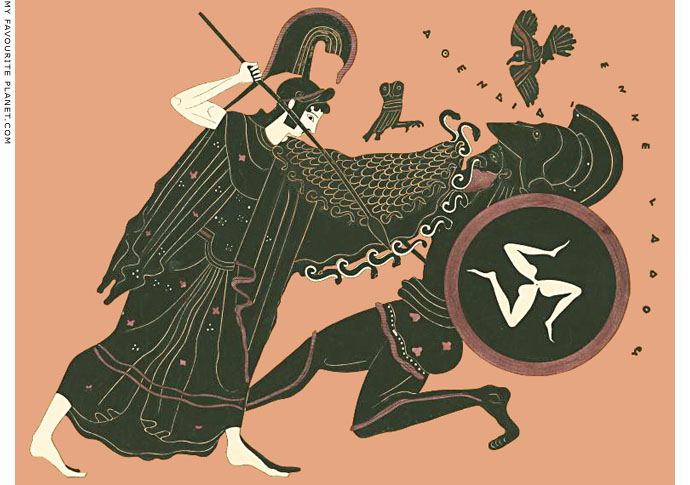
Drawing of a black-figure painting of Athena, with the aegis but without the Gorgoneion,
defeating the Titan Encelados. The names of the two combatants are inscribed above the
Titan's head and to his right. Athena pushes her aegis into the Titan's face so that he is bitten
by its deadly snakes. Encelados' large round shield is decorated with a triskelion, symbol of
Sicily, where he was swallowed by Aetna. A falcon or hawk seems to combat Minerva's owl.
Source: lithograph by Kaeppelin of a painting on an amphora from Tyre
in Rouen Museum, France. In: Charles Lenormant and J. de Witte,
Elite des monuments céramographiques, Volume I, Plate 8. Leleux, Paris, 1844. |
|
Gorgon note
The illustrations and information about the Gorgon Medusa from this page can now be seen on the Gorgon Medusa pages in the MFP People section.
3. Gold stater of Athena as Palladion from Pergamon?
"But there came a phantom, as it seemed to us onlookers,
of Pallas, with plumed helm, brandishing a spear."
Euripides (circa 480-406 BC), Heracles, lines 1002-1003.
These staters are very rare, and while there is no direct evidence of their origin, some numismatologists believe they were minted in or around Pergamon (Mysia), perhaps as early as 334-332 BC, while Alexander the Great was still campaigning against the Persians in Anatolia (Asia Minor), before his victories gave him control over the area and allowed him to mint his own imperial coinage there. This may explain the depiction of Herakles wearing the skin of a lion's head on the obverse side, as on other coins issued by Alexander. On later coins of his successors, the Hellenistic rulers in Greece and Asia, Alexander was depicted as Herakles (see the article on the Alexander the Great page in the MFP People section).
The type of image of Athena with raised spear and shield is often referred to as Palladion (Greek, Παλλάδιον; Latin, Palladium), as symbol of the protector of the city, after an ancient cult image of Pallas (Παλλὰς) in Troy.
Debate continues about the identity of the protector goddess of the areas of Pergamon and Troy before the arrival of the Greeks. Pallas may have been originally a local Anatolian deity, who the Greeks identified with Athena (as Pallas Athena, Παλλὰς Ἀθηνᾶ), in the way that worship of the prehistoric mother goddess of Ephesus (akin to Kybele) was assimilated by the Ionian Artemis cult.
See also:
A Campana plate with a depiction of Athena as Palladion, on the Medusa pages of the MFP People section.
An Athenian vase painting showing the Homeric Greek hero Diomedes stealing the Palladion at Troy, in Homer part 2 in the MFP People section.
Calathus / polos / modius
It is notable that Athena is not wearing the helmet usual to depictions of her in Greek art; a crested Corinthian helmet is shown to her right. Descriptions of these coins refer to the tall headdress worn by the goddess as a calathus (Greek, κάλαϑος, kalathos; Latin, calathus). The term calathus has also been applied to a variety of hats or crowns in images of Greek and Roman deities (particularly those of eastern origin) such as Kybele, Demeter, Persephone, Tyche (known to the Romans as Fortuna), Plouton (Hades), Apollo Hieropolitanus, Jupiter Serapis and - as in this case - Athena. Rulers were also depicted wearing the calathus, including the Seleucid queen Cleopatra Thea (on a tetradrachm, circa 150 BC).
There appears to be much confusion concerning the terms calathus and polos (πόλος, literally pivot, axis; the origin of the English words pole and polar) in modern descriptions of ancient images, as the latter is also used to describe the cylindrical headgear worn by goddesses. The term modius, the name for a similarly-shaped Roman vessel used to measure corn (shown on coins as a symbol of prosperity and economic security), is also used.
Both terms polos or calathus are used for a wide variety of headdresses, including simple tall hats, coiled cloth, and elaborate "mural crowns" depicting a walled city, often topped by a temple (photo of Artemis statue below).
The Greek word kalathos (also kalathiskos, see photo below) is thought originally to have signified a basket used to store spinning and weaving materials. Kalathoi were later made of clay, wood and metal, usually with a cylindrical or tapering form, often with a lipped or flared rim; some resembled modern plant-pots, while others have been described as being lily-shaped (Latin, quasillus). This type of vessel was also known as a talaros.
In ancient literature and art they are used to hold fruit, flowers, milk, cheese, oil and wine, and were associated with women's domestic quarters, as well as with maidenhood and fertility. During festivals in honour of Demeter, kalathoi containing sacred objects were carried in processions. Other ancient vessels now known as kalathoi were decorated with images typical of antique pottery and metalwork, for example Alcaeus and Sappho or Dionysos and the Maenads.
|
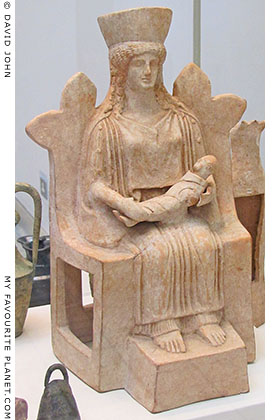
Terracotta figure of a seated woman holding a baby.
From Thebes, Greece. Made in Boeotia, 450-440 BC.
British Museum. GR 1911.4-16.2 (Terracotta 820). |
|
| |
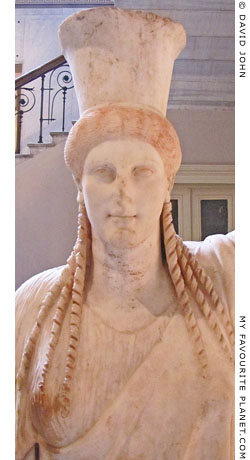
Archaistic marble statue of a
caryatid wearing a calathus / polos
headdress. From Tralles (Aydin).
1st century BC,
time of Emperor Augustus.
Istanbul Archaeological Museum.
Inv. No. 1189 T (Cat. Mendel 541).
See also the Townley Caryatid. |
| |
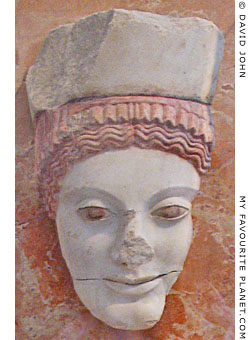
The "Polos Kore", a marble head
of an Archaic kore (maiden) statue
wearing the high polos headdress.
Around 500 BC. Found in 1888 near
west end of the Parthenon, Athens.
Pentelic marble. Height 27.5 cm.
Acropolis Museum, Athens.
Inv. No. Acr. 696. |
| |
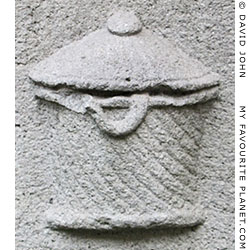
Relief of a basket on an altar or
statue base from Pergamon.
Roman period.
Bergama Archaeological Museum. |
| |
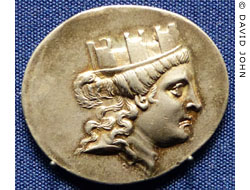
Tetradrachm coin from Smyrna
(today Izmir), 180-140 BC,
showing the goddess Tyche
wearing a mural crown.
Münzkabinett, Staatliche Kunstsammlungen, Dresden. |
| |
| |
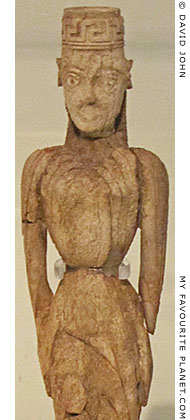
Detail of an ivory stauette
(24 cm high), depicting
a nude goddess wearing
a polos decorated
with a meander.
Greek work influenced by
Near Eastern (Syrian) art.
From one of the Dipylon
graves in Kerameikos,
Athens, 730-720 BC.
Height 24 cm.
National Archaeological
Museum, Athens.
Inv. No. 776. |
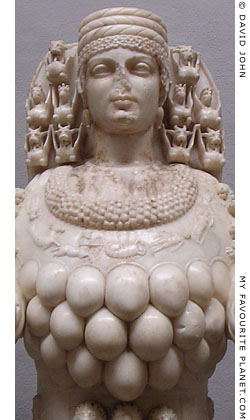
Detail of the "Beautiful Artemis",
a marble statue of Artemis Ephesia
depicting the goddess wearing
a coiled headdress.
Roman Imperial period,
125-175 AD.
Ephesus Museum, Selçuk.
Inv. No. 718.
See more photos and information
about this statue of Artemis in
Selçuk gallery 2, page 1. |
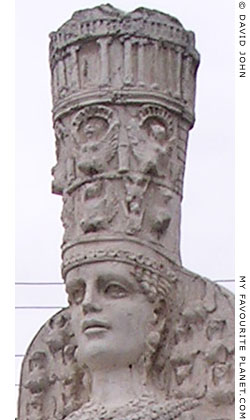
Detail of a modern copy of a
statue of Artemis from Ephesus
in a fountain in Selçuk, Turkey.
The original is in the
Ephesus Museum, Selçuk.
Here the goddess has been
given a much more elaborate
headdress, with two tiers of
fabulous animals in an
architectural setting (arches in
the middle tier) and topped by
a model of the Great Temple of
Artemis, the Artemision, one of
the Seven Wonders of the World. |
|
| |
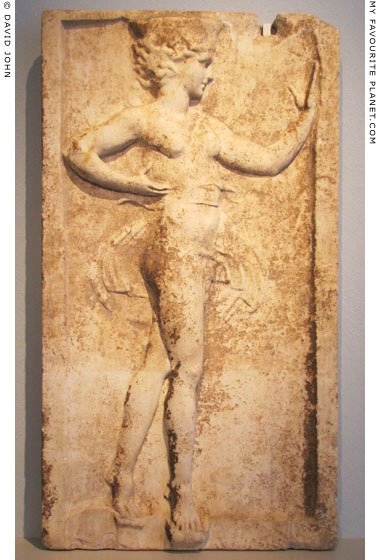
The so-called "Kalathiskos Dancer", a Neo-Attic
marble relief depicting a young dancing woman
wearing a basket-like headdress (kalathiskos)
and a swirling, transparent chiton.
Thought to have been made in a Neo-Attic workshop in
Athens for the Roman market in the 1st century BC, as
a copy of a Classical original, perhaps by Kallimachos.
Height 95 cm; width 54 cm; depth 10 cm;
relief height 3.5 cm.
Altes Museum, Berlin. Inv. No. SK 1456.
Acquired in Florence, Italy, in 1892.
See: 2336: Relief mit Kalathiskostänzerin.
Antikensammlung, Staatliche Museen, Berlin.
At arachne.uni-koeln.de. |
|
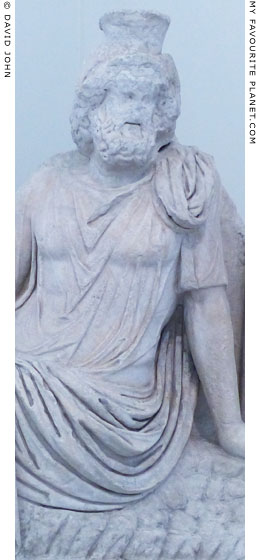
Detail of the so-called "Zeus Ammon"
(see gallery 2, page 19) now in
Naples. A large marble high relief
of the 2nd century AD, thought to
represent a river deity or a nymph,
to which a head from another statue
has been added. The head wears
what appears to be a polos.
National Archaeological Museum,
Naples. |
|
| |
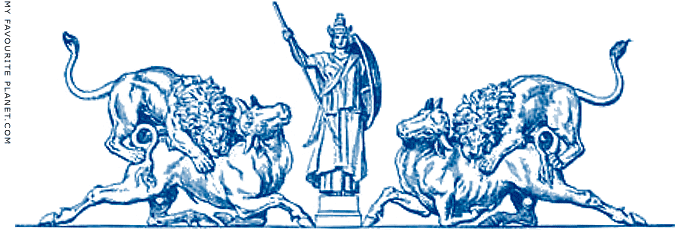
A statue of Athena flanked by a pair of sculptures of lions attacking bulls.
This image was used on the title page of the series of publications describing the results
of early archaeological excavations at Pergamon, produced by the Königliche Museen zu
Berlin (Royal Museums, Berlin, now the State Museums, Berlin, SMB). |
Maps, photos and articles: © David John,
except where otherwise specified.
Additional photos: © Konstanze Gundudis
All photos and articles are copyright protected.
Images and materials by other authors
have been attributed where applicable.
Please do not use these photos or articles without permission.
If you are interested in using any of the photos for your website,
project or publication, please get in contact.
Higher resolution versions are available on request. |
| |
 |
Visit the My Favourite Planet Group on Facebook.
Join the group, write a message or comment,
post photos and videos, start a discussion... |
|
|
| |
|
|
|